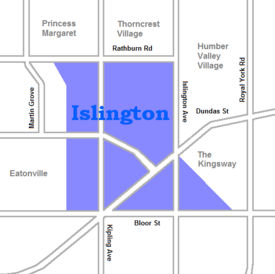Islington–City Centre West
| Etobicoke City Centre | |
|---|---|
| Neighbourhood | |

Towers in Islington-City Centre West
|
|
 |
|
| Coordinates: 43°38′55″N 79°31′43″W / 43.64861°N 79.52861°W | |
| Country |
|
| Province |
|
| City |
|
| Community | Etobicoke |
| Established | 1830s Settled 'Mimico', Etobicoke Twp 1860 (Postal village) 'Islington', Etobicoke Twp |
| Changed Municipality | 1954 Borough of Etobicoke from Township 1998 Toronto from Etobicoke |
| Government | |
| • MP | James Maloney (Etobicoke—Lakeshore) |
| • MPP | Peter Milczyn (Etobicoke—Lakeshore) |
| • Councillor | Justin Di Ciano (Ward 5 Etobicoke—Lakeshore) |
Islington–City Centre West (also known as Islington Village, Six Points or Etobicoke City Centre) is a commercial and residential neighbourhood in Etobicoke, Toronto, Ontario, Canada. One of four central business districts outside Downtown Toronto, it is bounded by Rathburn Road to the north, Islington Avenue to the east, Bloor Street to the south, Mimico Creek to the west.
Islington centres on a commercial strip along Dundas Street West (originally The Governor's Road, the first highway connecting Toronto to London, Ontario) which runs along an escarpment (the Lake Iroquois Shoreline, ancient shore of Lake Iroquois) across the width of Etobicoke. To the west where Kipling Avenue crosses Dundas Street West (and Bloor Street West) is the Six Points intersection, the central point in Etobicoke's grid. To the east, Dundas Street crosses the Mimico Creek. The original community called Mimico grew west of Montgomery's Inn, which was built in 1832 at Dundas Street West and Islington Avenue (beside the Mimico Creek) to serve travellers coming or going from Toronto to western Ontario along Dundas St. Unlike the better-known Montgomery's Tavern (formerly in North York, now demolished), Montgomery's Inn was used by soldiers remaining loyal to the government during the 1837 rebellion. Etobicoke was officially incorporated as a township in 1850, first using Montgomery's Inn for its meetings until the nearby original Methodist Church was purchased.
Etobicoke's first cemetery began with the burial of a traveller on Dundas who died on his way to Toronto just before reaching Montgomery's Inn. Despite the dying man's request to be buried in Toronto, he was buried beside the Methodist Church (later the Etobicoke Council Offices) in Islington. This cemetery remains a prominent historic site in the heart of Etobicoke where many of Etobicoke's early families are buried.
With the building of the first railway to Toronto from the west in 1855, Mimico, near Lake Ontario, petitioned the government for a post office to be called Mimico in 1858. In 1860, the original northern Mimico petitioned for its own post office, using the name Islington, which was suggested by the wife of Montgomery's Innkeeper who was born in Islington, England (now a part of London). A second railway was built at the bottom of the escarpment (just south of Dundas) preventing the collapse of Islington during the railway age. This neighbourhood was also the site of Etobicoke's annual rural fair. In the early 20th century, Etobicoke's urbanizing lakeshore communities separated to become independent municipalities while Islington remained a postal village, the administrative centre of rural Etobicoke Township. The Etobicoke municipal offices were greatly enlarged at this time.
...
Wikipedia
